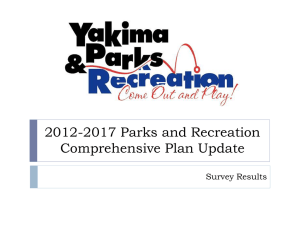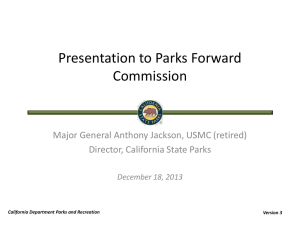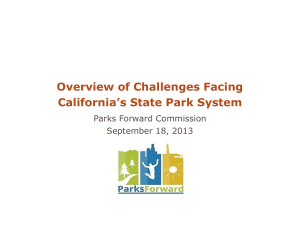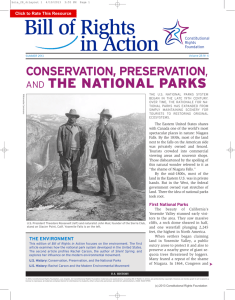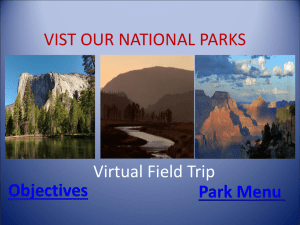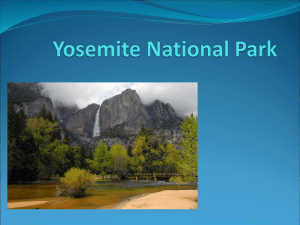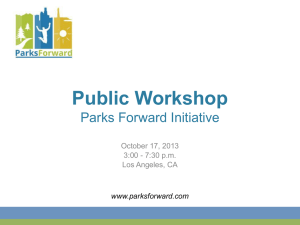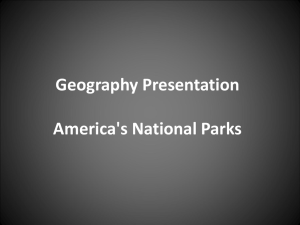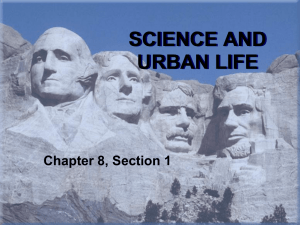PPT-National Parks
advertisement
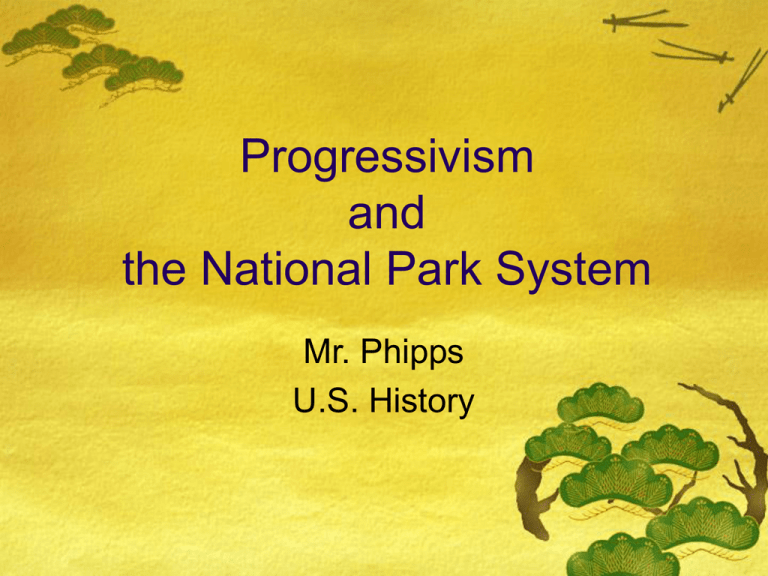
Progressivism and the National Park System Mr. Phipps U.S. History California State Standards 11.8.6. Discuss the diverse environmental regions of North America, their relationship to local economies, and the origins and prospects of environmental problems in those regions. 11.11.5. Trace the impact of, need for, and controversies associated with environmental conservation, expansion of the national park system, and the development of environmental protection laws, with particular attention to the interaction between environmental protection advocates and property rights advocates Introduction The National Park System is intended for • All public use • For Education • For Recreation Our National Park System provides • A sense of history • Protection of wildlife • Protection of important/unique geographic features • Patriotism • Conservation of valuable natural resources QuickTime™ and a TIFF (Uncompressed) decompressor are needed to see this picture. Timeline of Acts (1864) Yosemite Act: First state park/preserve (1872) Yellowstone Act: “Protect the Wonders” (1890) Chickamauga Act: First war memorial (1906) Antiquities Act: Authorized presidential power to create parks (1931) Predator Policy: Authorized parks as a “last stand” for victim species (1933) Civilian Conservation Corps: New Deal policy for employment, conservation, and maintenance of parks.established under $300,000,000 (1956-1966) Mission 66: Provided independent funding for park rejuvenation (1965) Concession Act: Guaranteed one concession per park (1969) National Environmental Protection Act: Set ground rules for Federal agencies (1998) National Park Omnibus Management Ac: Improved management of national parks In the Beginning State parks set aside to protect and preserve beauty Parks received little more than janitorial work Problem: no central organization and no laws to govern them Sec of the Interior, F. K. Lane, needed a dept to maintain the parks Yellowstone, Yosemite, and Sequoia John Muir (1838-1914) Background: • Born in Scotland • Immigrated to America in 1849. • Dropped out into “university of wilderness”. Employment: • Summer job of shepherd in Yosemite sparked naturalist interests • Started the Sierra Club "Most people are on the world, not 1892. in it; have no conscious sympathy or relationship to anything about them, undiffused, separate, and rigidly alone like marbles of polished stone, touching but separate.” John Muir Teddy Roosevelt and John Muir atop Hetch Hetchy The Early Years: 1864-1932 American authors wrote about the problems of the cities, advocated a return to nature Yosemite commissioned first state park (1890), later upgraded to national park (1906) Chickamauga National Park (1890) First battlefield park Earned recognition through President Theodore Roosevelt, who advocated conservation and preservation as part of his Square Deal National cemeteries already established after civil war Roads build to encourage tourist auto access Hetch Hetchy becomes the first major environmental debate: Should the gov’t permit damming for electricity and water usage? Commissioned Parks: Hot Springs, Yellowstone, Yosemite, Glacier, Zion, Rocky Mtn., Mt. McKinley, Grand Teton, Hawaii Volcanoes Stephen T. Mather (1867-1930) First director of the National Park Administration (1916-1928) for $4,500 annual salary Selected national parks for their uniqueness Employed “quality” people, such as veterans Upgraded park grounds for public appeal “There will never come an end to the good that he has done” Mathers Epitaph Yellowstone: 1872 1870: Marked first “official” exploration of the territory; • • Gen. Henry D. Washburn led U.S. cavalry to protect western settlers from the Crow and Blackfeet Legends of park spread through word of mouth 1872: Congress passed act for “enjoyment of the people” Later acts included botany, zoology, geology and commercialism Travel was recently available from the N. Pacific RR, but unsafe because of Chief Joseph and the Nez Perce Yosemite: 1890 Government responded to environmental degradation by the gold diggers to keep the tourism alive John Muir Nat’l Park Bill in 1890 established area as state preserve National guard spent 30 years to protect park from poachers QuickTime™ and a TIFF (Uncompressed) decompressor are needed to see this picture. Ansel Adams Started work for national parks in 1919 as a janitor for the Sierra Club HQ. Love of nature sparked by friend Francis Holm Eastan, experimenting with natural photography Became main photographer of the natural beauty found in the national parks Kings Canyon becomes a national park in 1940 under FDR Aspen Grove El Capitan, Yosemite Grand Tetons Saguaro Forest, Arizona Saguaro Cactus, Arizona Pueblo, New Mexico L.A. Freeway, 1960 National Park Service National Park Service: Established August 25, 1916 Qui ckTi me™ and a TIFF (Uncompressed) decompr essor are needed to see this pictur e. “Our goal is to offer a window into the historical richness of the National Park System and the opportunities it presents for understanding who we are, where we have been, and how we as a society, might approach the future.” Concessions Started as liaisons between private business, national parks, and the government Relationship changed as a result of modern transportation • Railroad and automobiles transformed transportation • Required new routes and services QuickTime™ and a TIFF (Uncompressed) decompressor are needed to see this picture. Mather appointed one concessionary to each park Awahnee Hotel, Yosemite Valley From New Deal to Post War: 1933-1956 CCC provided disciplined program: 5 year plans finished in 1 season Drop in funding during WWII resulted in a short decline in National Park System The expansion of the Grand Teton Nat’l park set sparks off between state and congressional legislation Historian, Bernard DeVoto suggested that the parks be closed until they could be properly funded and operated Everglades, Big Bend, Virgin Islands, Olympic, Kings Canyon, and Grand Teton The CCC Boys Established 1933 New Deal reform to employ young men in conservation work 63,256 buildings, 3,116 lookout towers and 28,087 miles of trails; erected 405,037 signs, markers, and monuments; planted 45 million trees; and fought countless fires. They developed more than 800 state parks QuickTime™ and a TIFF (Uncompressed) decompressor are needed to see this picture. The Happy Days 1957-1980 The “Report of the Advisory Board on Wildlife Management in the National Parks” inspired by naturalist authors resulted in a permanent staff of scientists in each park to preserve the "condition that prevailed when the area was first visited by the white man.” Bureau of Outdoor Recreation est. 1962 1971- 180 million visitors State of the Parks Report indicates significant problems: overcrowding, overbuilding, and insufficient personnel to protect the environment Canyonlands, Guadalupe Mtn., North Cascades, Redwood QuickTime™ and a TIFF (Uncompressed) decompressor are needed to see this picture. 1981-present Continued tourism results in poor management, ecosystem failure, and decline personnel morale Over half of Yellowstone burned in a fire during 1981 1984--Bear interaction causes parts of Yellowstone to be closed off from the public 1992= 75th birthday of Park service Anthropocentrism vs Biocentrism: human or animal/environmental focus Great Basin, Channel Islands, Biscayne, Death Valley, Joshua Tree, Great Sand Dunes, Black Canyon In Sum The National Park Service oversees: • • • • Over 390 units of land Over 58 national parks Over 84.4 million acres of land Fundamental American historical sites (including Ellis Island, the Statue of Liberty, etc) • Preserves important sites to our common American heritage • Conserves natural resources, mineral resources, rare geological resource, and numerous species

